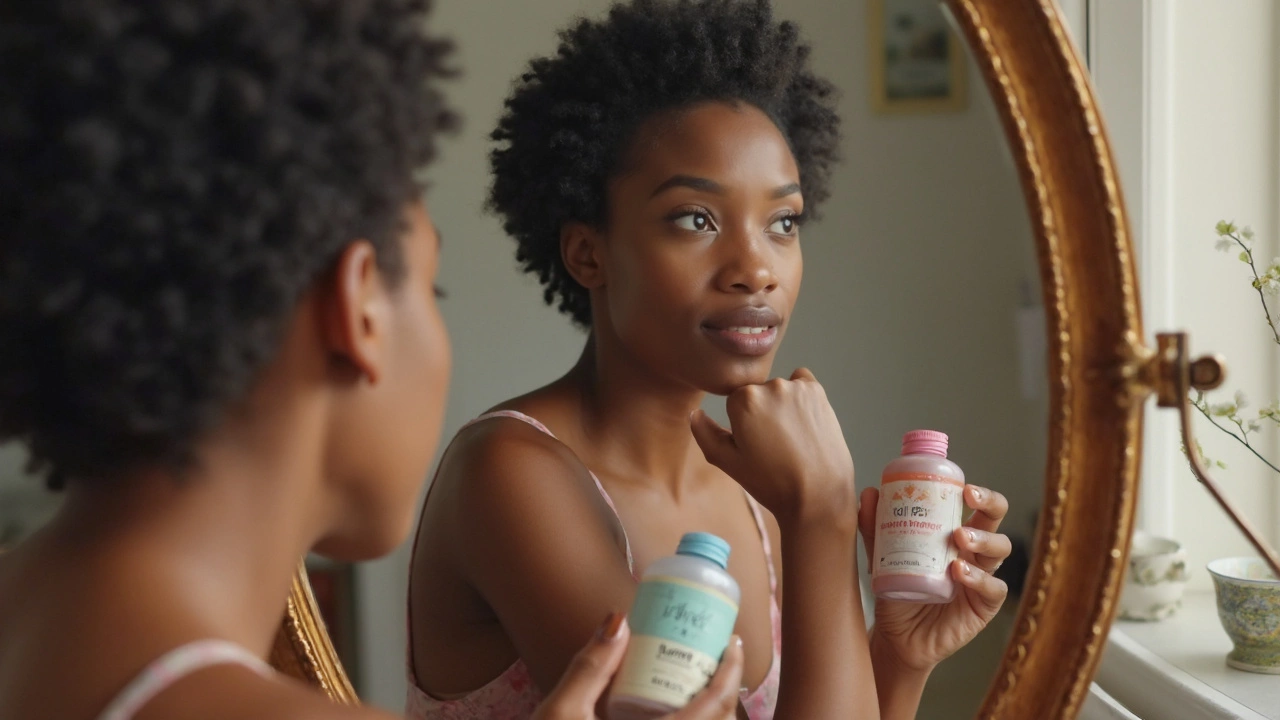
Look at the back of most skincare bottles and you might feel like you’re reading a chemistry workbook. Imagine slathering that stuff on your face every day for years. Sure, it might smell nice, but your skin absorbs way more than you think—sometimes even up to 60% of what you put on it. That means those hard-to-pronounce chemicals aren’t just sitting on the surface.
Switching to organic skincare isn’t just about hopping on a trend. A big reason more people are ditching mainstream products is irritation. Redness, breakouts, weird dry patches—these can all be reactions to artificial fragrances or preservatives hidden in regular creams and cleansers. Organic options ditch most of those harsh extras and focus on simpler, cleaner ingredients.
If you’ve ever wondered if organic products can actually do the job, you’re not alone. The truth is, a lot of the powerhouse ingredients in high-end beauty products—like plant oils, shea butter, or aloe—are the same ones you’ll find in organic stuff, just without the long list of fillers.
- How Regular Skincare Stacks Up
- What 'Organic' Really Means
- Hidden Dangers in Mainstream Products
- How to Make the Switch (Without Going Broke)
- Spotting Genuine Organic Skincare
How Regular Skincare Stacks Up
Flip through your average bottle of face wash or moisturizer. You’ll see a long list of ingredients—some that sound sort of friendly, like “glycerin,” and others that just look straight-up intimidating, like “methylparaben” or “propylene glycol.” Most mainstream skincare brands use a cocktail of synthetic stuff to make their products last longer, look prettier, and smell better. It’s not just about cleaning your skin—it’s about keeping shelves stocked and wallets happy for big companies.
Common additives in regular skincare include:
- Artificial fragrances – These make things smell good, but can trigger allergies or skin irritation.
- Preservatives – Like parabens and formaldehyde releasers, which keep products from growing mold but have raised health concerns in some recent studies.
- Sulfates – These create foam but can strip skin’s natural oils and lead to dryness.
- Silicones – Make your skin feel smooth, but don’t actually boost its health.
A study from 2022 found parabens in about 75% of non-organic face creams in the US and Europe. And while most mainstream brands say what they use is “safe in small amounts,” it’s the repeated, daily exposure that has more people paying attention.
| Ingredient | Typical Purpose | Common Issues |
|---|---|---|
| Parabens | Preservative | Hormone disruption (suspected) |
| Sulfates | Cleansing agent | Dries out skin |
| Phthalates | Fragrance fixer | Allergic reactions |
| Mineral Oil | Moisturizing | Clogs pores (sometimes) |
Regular skincare products might give quick smoothness, but you’re not always getting long-term health benefits. The quick fixes from some chemicals can hide bigger problems—like a weakened skin barrier or sneaky sensitivities that only show up over time. That’s why so many are now curious about what organic skincare can do differently.
What 'Organic' Really Means
The word organic skincare gets tossed around a lot, but it’s more than just a cool label on a fancy bottle. To really be organic, skincare ingredients have to be grown without synthetic fertilizers, pesticides, or genetically modified organisms (GMOs). This doesn’t just sound nice—it means fewer chemicals are ending up both on your face and in the environment.
Here’s where it gets tricky. There’s no single worldwide standard for what counts as “organic.” In the USA, for example, the USDA gives a special green seal to products that have at least 95% certified organic ingredients. Europe, Australia, and Japan have their own rules and stamps, too. If you see “made with organic ingredients,” that could mean only 70% of the stuff inside is actually organic. It helps to check for these seals on your products:
- USDA Organic (USA)
- Soil Association (UK)
- Ecocert (France, but seen worldwide)
- ACO (Australian Certified Organic)
It’s not just about where ingredients come from. Organic standards also say no to common nasties like parabens, phthalates, and artificial dyes. You’re getting real plant oils and extracts, not just a bottle of filler with a single “natural” ingredient thrown in for show.
Curious how organic stacks up against regular products? Check this out:
| Organic Skincare | Regular Skincare | |
|---|---|---|
| Main ingredients | Plant-based, grown without synthetic chemicals | Often synthetic, may use pesticides and GMOs |
| Preservatives | Natural (like Vitamin E or rosemary extract) | Artificial (parabens, formaldehyde releasers) |
| Fragrance | Essential oils, pure plant extracts | Artificial fragrances, potential allergens |
The bottom line? Not all “natural” products are actually organic skincare. Booster words like “pure” or “botanical” sound nice, but if you’re trying to cut out chemicals, check the label for those official organic stamps and a short ingredients list you recognize.

Hidden Dangers in Mainstream Products
Ever tried decoding the label on a drugstore moisturizer? You’ll find stuff like parabens, sulfates, and phthalates lurking in most non-organic skincare. The reason? These ingredients make products last longer or create foam and fragrance, but they aren't exactly kind to your skin—or the planet.
- Parabens are cheap preservatives. They keep mold away but can mimic estrogen in your body. Way back in 2004, a British study found parabens in breast tumor tissue, which kicked off tons of research and debate. Some countries in Europe even limit how much can be used.
- Sulfates (like sodium lauryl sulfate) make cleansers and shampoos foamy. They strip dirt—and natural oils—leaving skin dry or itchy. If your face always feels tight after washing, sulfates could be why.
- Phthalates help scents last longer and keep products soft and flexible. Studies have linked some phthalates to hormone disruption, which is still being researched, but it made enough noise for companies to start pulling them out—especially in baby products.
Then there’s the issue of artificial fragrances and dyes. "Fragrance" sounds so innocent, but it can be a cocktail of 100+ chemical ingredients, none of which companies have to list. This mess of synthetics is a top cause of allergic reactions and sensitivity.
Check this out—some common additives in everyday products don’t actually benefit your skin health or appearance. They're just there for texture or shelf life. Take a look at this quick comparison:
| Ingredient | Mainstream Purpose | Potential Risk |
|---|---|---|
| Parabens | Preservative | Hormone disruption |
| Sulfates | Foaming agent | Skin barrier damage |
| Phthalates | Stabilizer/Fragrance enhancer | Hormone disruption |
| Artificial fragrance | Scent | Allergic reactions |
If you’re trying to avoid unwanted breakouts or sensitive skin days, keep an eye out for these ingredients next time you’re shopping. Organic skincare skips most of them, so you get simpler, cleaner products with fewer surprise side effects.
How to Make the Switch (Without Going Broke)
Thinking about changing your routine to organic skincare doesn’t mean you need to toss out every product overnight. Besides, some organic brands are pricier at first glance, so doing a total overhaul in one shopping trip can hurt your wallet. The smart move? Phase things in over time and focus on what matters most for your skin.
Start with products that stay on your skin the longest, like moisturizers and serums. Cleansers make less contact since you wash them off, so you can switch those later. Don’t fall for marketing hype—just because something says "natural" or "plant-based" doesn’t guarantee clean ingredients. Look for real certifications like USDA Organic or COSMOS. These actually mean something and aren’t just buzzwords.
- Prioritize basics like a gentle cleanser, a good moisturizer, and sun protection. These three handle your daily needs.
- Use up your current products before buying new ones. No need for waste, and your budget will thank you.
- Try smaller travel sizes or sample packs from organic skincare brands before committing to full sizes.
- DIY can be a game-changer for some products. Simple masks with oatmeal, honey, or avocado save cash and skip fillers.
- Watch for sales or subscribe to brands' newsletters for exclusive deals. Many companies offer discounts if you buy direct.
Here's a quick look at how switching staple products can affect your spending over a year:
| Product Type | Regular Brand (Annual Avg.) | Organic Brand (Annual Avg.) | DIY/Minimalist Option |
|---|---|---|---|
| Moisturizer | $60 | $75 | $25 (coconut oil, shea butter) |
| Cleanser | $45 | $55 | $15 (honey, oats) |
| Sunscreen | $50 | $60 | N/A (DIY not recommended) |
You can see that swapping to organic skincare doesn’t always blow your budget, especially with smart picks and a few DIY swaps. It’s about swapping smarter, not faster. Focus on what touches your skin most, look for real certifications, and don’t get caught up in the hype. Your skin (and your bank account) will be better for it.

Spotting Genuine Organic Skincare
Anyone can slap “organic” or “natural” on a label, but that doesn’t mean it’s the real deal. The truth is, there’s no global law holding brands to strict standards, and some companies stretch the truth just to sell more bottles. So, how do you spot legit organic skincare and avoid wasting your money?
- Look for certifications: Trustworthy symbols like USDA Organic (in the US), COSMOS Organic, or Ecocert actually mean something. These groups check ingredients, how they’re grown, and what goes into the bottle. No certification? Be extra skeptical.
- Read the ingredients list: If the first five ingredients are clean and plant-based—like aloe vera, jojoba oil, or shea butter—you’re on the right track. Watch out for words like "parabens," "synthetic fragrance," or anything with "PEG" in it. Shorter, simple lists are usually better.
- Ignore packaging hype: Just because the bottle is green or has a leaf on it, that doesn’t make the product organic. Focus on what’s inside, not marketing fluff.
- Check the percentage of organic ingredients: Some products say “made with organic ingredients,” but only a tiny percent is actually organic. Certified products will tell you up front. For example, USDA Organic products need at least 95% organic ingredients.
Here’s a quick snapshot of what some of the main certifications mean. If you see these, you can usually trust the organic skincare claims:
| Certification | Main Requirement |
|---|---|
| USDA Organic | 95% or more organic ingredients, strict on synthetic chemicals |
| COSMOS Organic | At least 95% of plant-based ingredients are organic |
| Ecocert | At least 95% plant-based, minimum 10% overall organic |
Another tip—avoid “fragrance” or “parfum” in your products. These are often just chemical cocktails that might mess with sensitive skin. Product names like “natural,” “pure,” or “clean” aren’t regulated and don’t prove anything.
If you really want to play it safe, try brands that are open about where their ingredients come from and show full transparency on their website. When in doubt, Google the ingredient list. If it reads like your grandma’s pantry, it’s probably safer than something looking like a chemistry quiz.